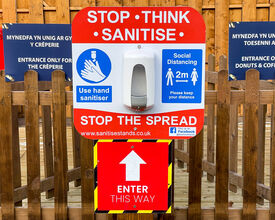Who would ever think that we wouldn’t have events in 2020? Just saying those words out loud sounds crazy, even after the crisis we’ve experienced. It’s still unbelievable and a shock for all of us. But the good news is that the economy is gradually reopening, and soon we’ll start running events again. But how do we get people comfortable with the idea of attending events again?
After so many months of lockdown and a continuous stream of media messages regarding the dangers of this epidemic crisis, your potential attendees may feel anxious about attending your events again. You may end up having a much smaller attendance rate than you’re used to.
That’s why your new role as an organizer is to ensure that guests are safe at your events so that they’ll trust physical events again. By doing so, you’ll be able to get your normal attendance rate back and be a responsible contributor to the “new normal.” So how can you ensure people’s safety at your events and rebuild the trust they’ve lost in face-to-face engagements? Here are some initial steps to consider when planning your first event after the epidemic crisis:
Step 1. Start by running local events
Take things slow. There’s no need to put your attendees in the situation of flying to a different location and exposing themselves to a certain level of risk. Instead, think locally and start by planning events in your city. Apart from keeping your guests safe, you’ll also contribute to your local economy, which is crucial these days considering the lockdown’s impact on so many businesses. You’ll be able to engage with local event providers, help them increase their own business, and get the economy moving again. As for the attendees, they’ll be more eager to attend a local event than to travel somewhere else.
Step 2. Ensure social distancing at your events
Forget about those compact venue rooms with people crammed together shoulder to shoulder. To guarantee your attendees’ safety and make them trust events again, you’ll need to rethink where they sit. You may want to place your guests at a certain distance and book a larger event venue than normal. Yes, physical events are about bringing people together, but we’ll have to get used to the new settings and find different ways of gathering a mass of people without endangering their health.
Step 3. Break large events into smaller experiences
Forget about big events for a while. Instead of trying to gather thousands of attendees together, you have to think small for now and run micro sessions with fewer guests. Let’s take a conference, for example. Normally, it’d be a two- or three-day event with dozens of activities per day. But now, you’ll need to recreate the entire conference format and maybe run one or two workshops per day during an entire week with a limited capacity. Instead of just running a workshop once, you can run the same workshop for a few days so that more people will be able to attend. Keep your events small and extend them during a larger period of time.
Step 4. Create a biosafety guideline for your team
Your team will be at the forefront of your event. They will be engaging with the attendees, registering them, showing them the rooms, and answering any questions. So not only do you need to keep your guests safe, but you need to keep your team safe, too. Create a biosafety guideline that outlines the necessary precautions each team member should take. If possible, create the guideline in coordination with an epidemiologist who can help you define the essential practices and avoid anything that may compromise people’s safety. Your guideline may contain things such as outlining situations in which your team must wear a mask or how they should interact with the attendees, as well as the venue preparation and marking the distances people should have between each other.
Step 5. Communicate all these rules to your attendees
Before the event, create an email campaign around communicating the biosafety rules. This will help you avoid any misunderstandings, prepare your guests, and make them feel at ease knowing that you took all the necessary measurements to ensure their safety. Create an easy-to-understand email with the basic biosafety rules people should follow from the moment they enter the venue. You can reinforce the message by displaying the same rules at the entrance and encouraging people to take a second look at them.
Bonus step
Make unnecessary interactions digital. For example, there’s usually a crowd of people gathering at the venue’s front desk for registration. To ensure the biosafety of both your team and attendees, instead of setting up a registration desk, digitize the check-in process by sending your attendees the badge or QR code they can use via their phone to access the venue.








